Jump to Section
23 Common Garden Birds in the UK (Full Guide with Pictures)
Last updated: 17 February 2023
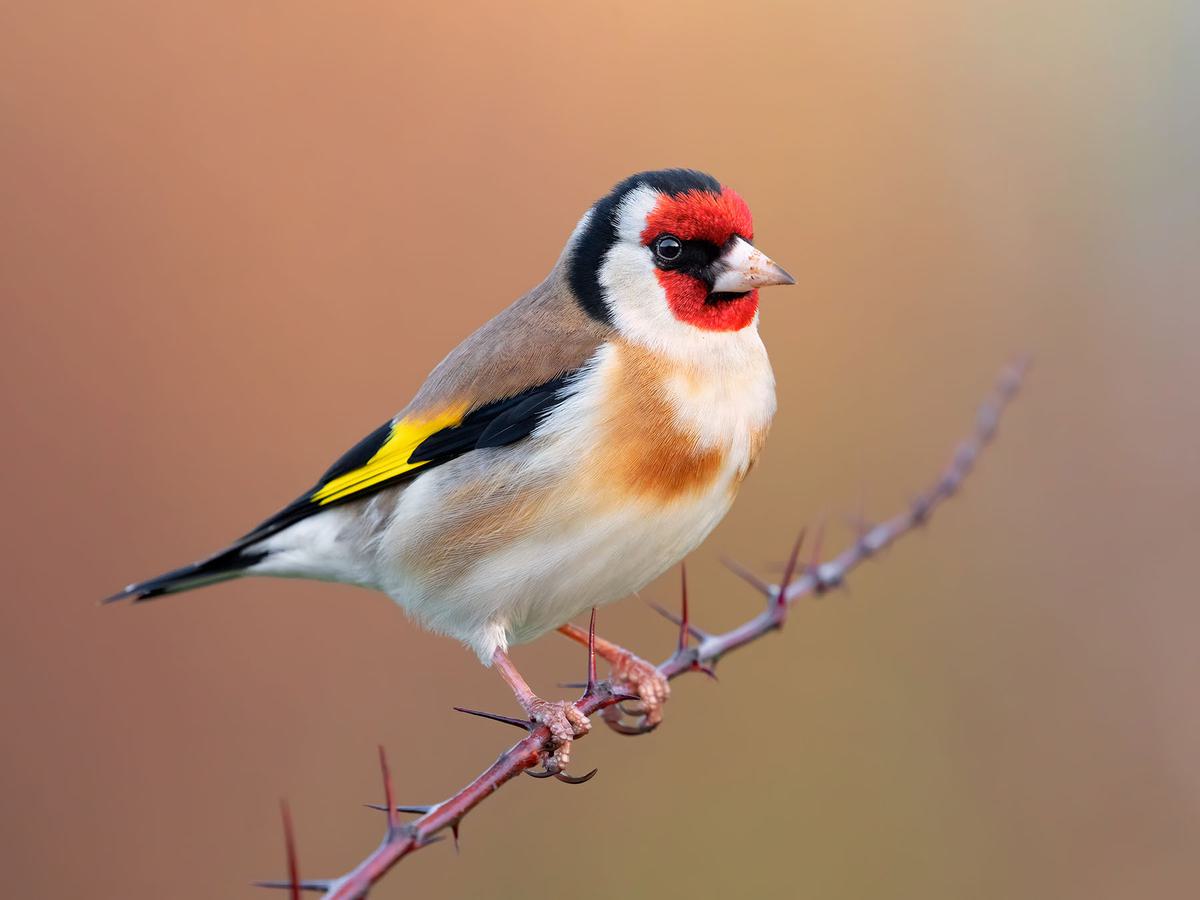
An outing to the countryside is a lovely way to spend the day, but bird watchers in the UK don’t need to leave home to enjoy some fantastic wild bird species.
The United Kingdom is blessed with a host of wonderful garden bird species, from the tiny Wren to the heavyset Carrion Crow. These delightful creatures share our outdoor environments, providing hours of entertainment and a real connection with the natural world.
Would you like to learn to identify and attract more wild British garden birds to your garden? Read along to discover 23 garden species that might already call your garden home. We’ll also learn some interesting facts about them and give you some tips on their favourite foods.
Blackbird
Turdus merula
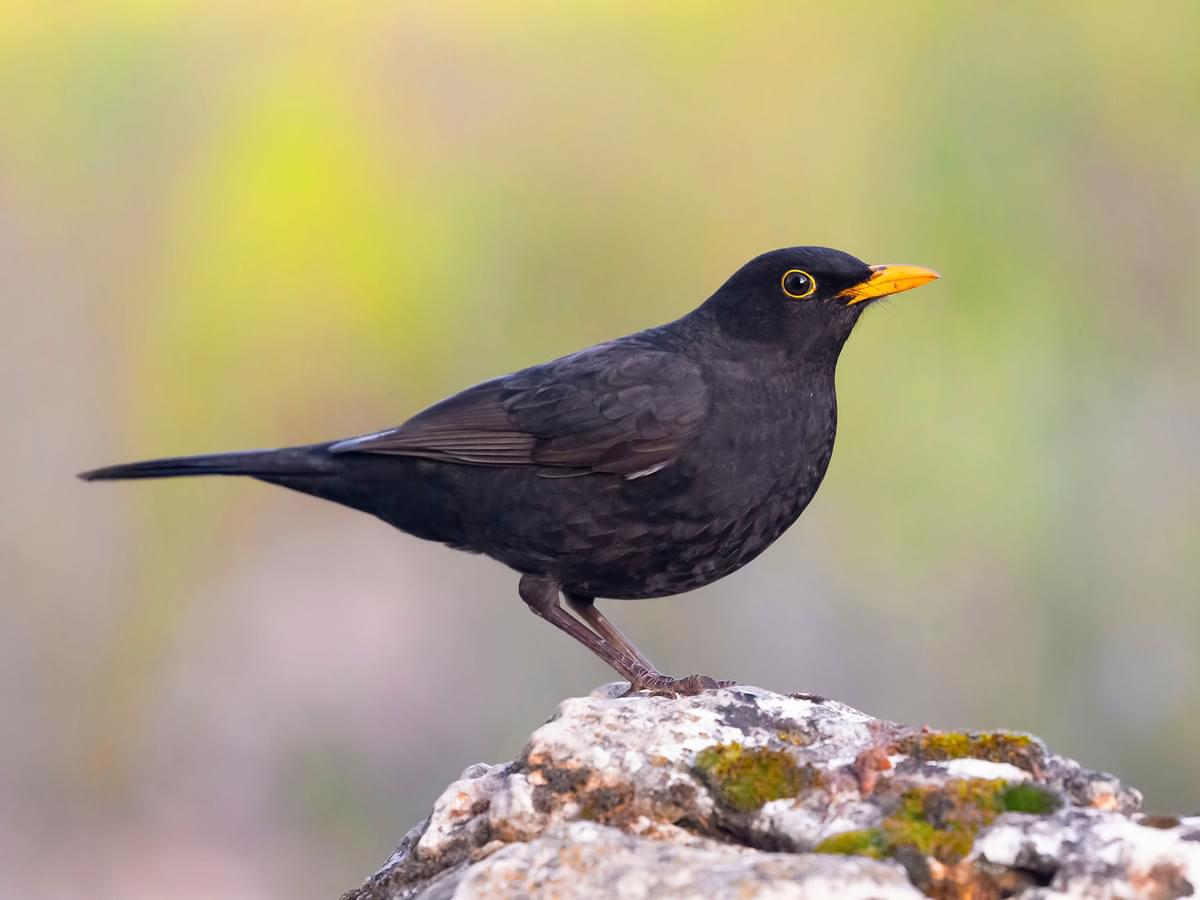
Length:
23cm to 29cm
Wingspan:
34cm to 38.5cm
Weight:
80g to 125g
Blackbird
The Common Blackbird (Turdus merula) is a ubiquitous, medium-sized garden bird in the UK. Males are black with a contrasting orange bill, while females are brown with a brown bill.
Blackbirds visit our gardens throughout the year, and their sweet song often rings out at the break of dawn. Common Blackbirds feed predominantly on insects but also eat berries when available.
They find gardens throughout the UK to be rich foraging grounds, although providing a water feature/ bird bath and their favourite foods like fat balls and mealworms will make your outdoor environment even more attractive.
Blue Tit
Cyanistes caeruleus
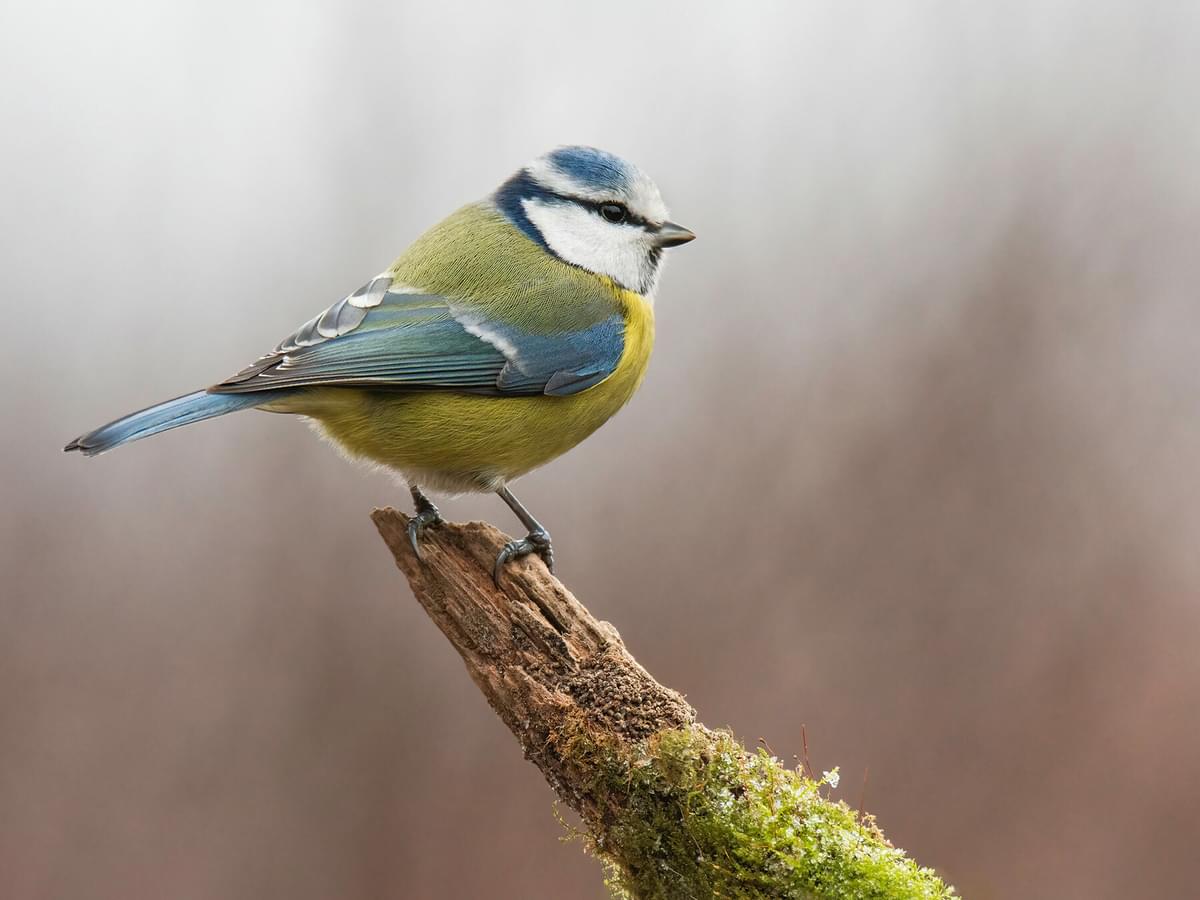
Length:
11.5cm to 12cm
Wingspan:
18cm to 20cm
Weight:
9g to 12g
Blue Tit
The Eurasian Blue Tit (Cyanistes caeruleus) is a colourful little bird with bright blue, white, yellow, black, and green shades.
This widespread species is a common visitor to gardens where they actively forage for caterpillars and small insects.
These lovely birds will visit bird feeders where seeds, nuts, and fat balls are provided. You can even encourage Blue Tits to nest in your garden by setting out a nest box.
Great Tit
Parus major
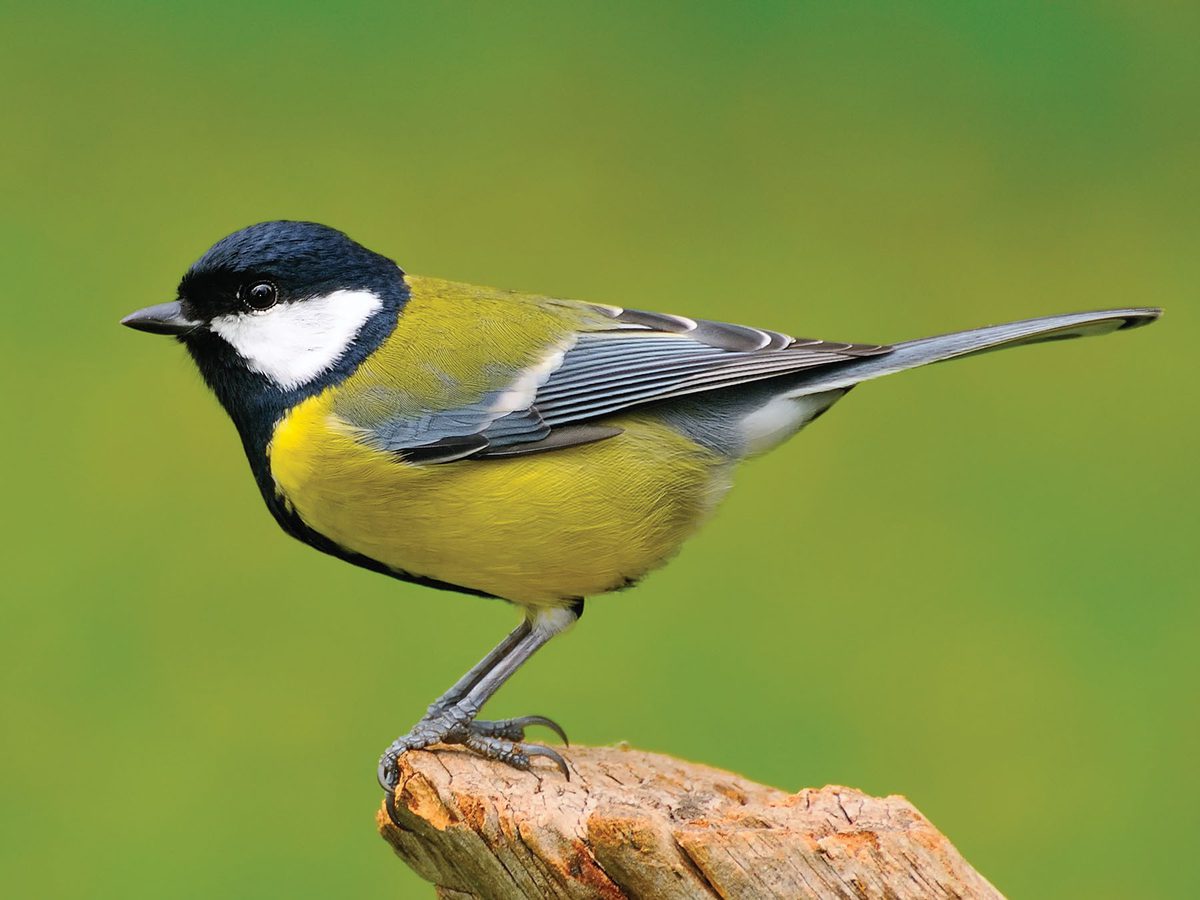
Length:
14cm to 16cm
Wingspan:
24cm to 26cm
Weight:
14g to 22g
Great Tit
The Great Tit (Parus major) is yet another bold and colourful garden species familiar to many British and Irish birdwatchers.
These non-migratory songbirds regularly visit bird feeders where they can be rambunctious and even downright aggressive towards other garden birds.
The Great Tit is similar in appearance to the Blue Tit but has a black (rather than blue) cap and throat. The species is also significantly larger than its blue cousin, although the two often forage together, especially in the colder months.
Birdwatchers can spot them throughout the UK (apart from the north of Scotland) and the rest of Europe.
European Goldfinch
Carduelis carduelis
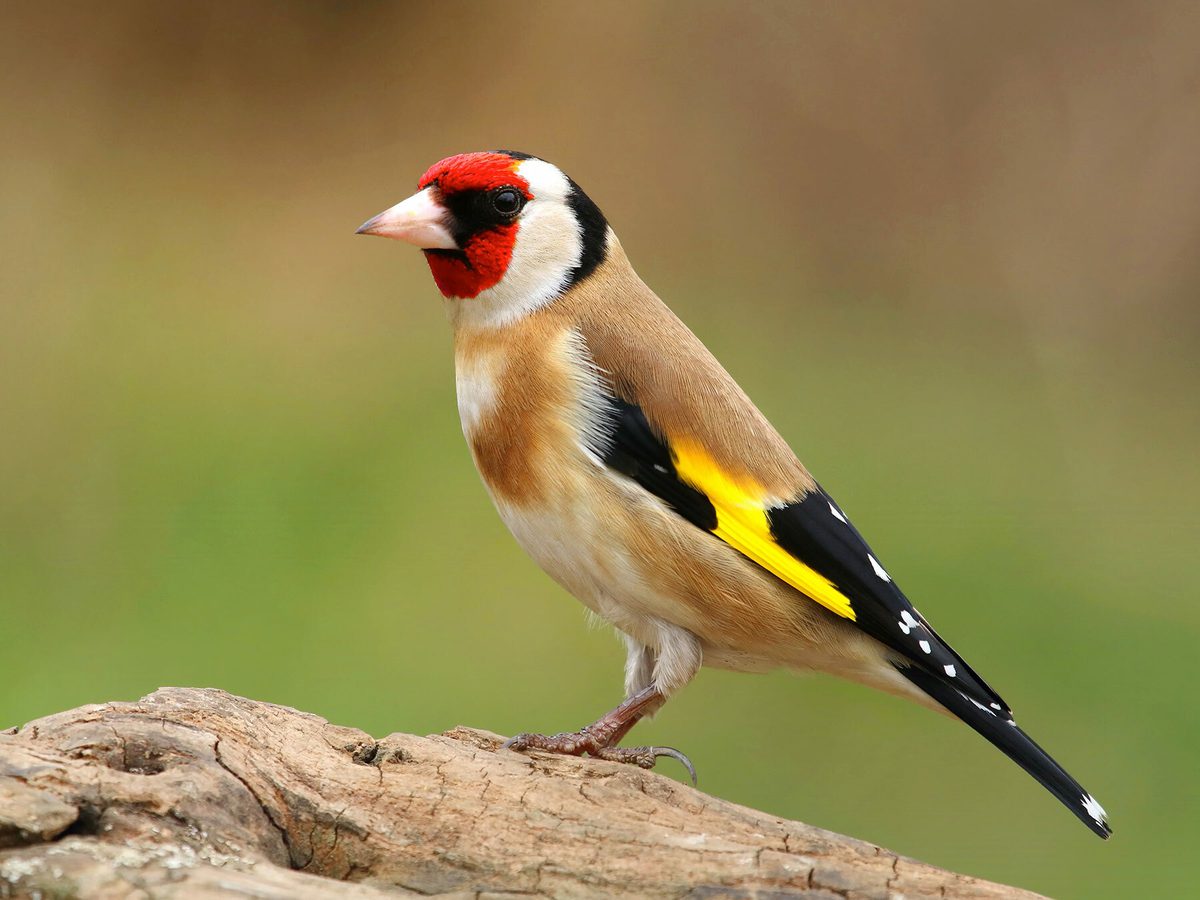
Length:
12cm to 13cm
Wingspan:
21cm to 25cm
Weight:
14g to 19g
Goldfinch
The European Goldfinch (Carduelis carduelis) is a welcome sight wherever they turn up. These bold and bright little seedeaters are easily identified by their scarlet, white, and black faces and contrasting black and yellow wing feathers.
European Goldfinches are specially adapted to feed on fine seeds like thistle, and thankfully, they will happily visit your garden, especially if you hang up a nyjer bird seed feeder.
They are most common in the south of the UK, and although some are present throughout the year, you are most likely to spot them in summer.
European Robin
Erithacus rubecula
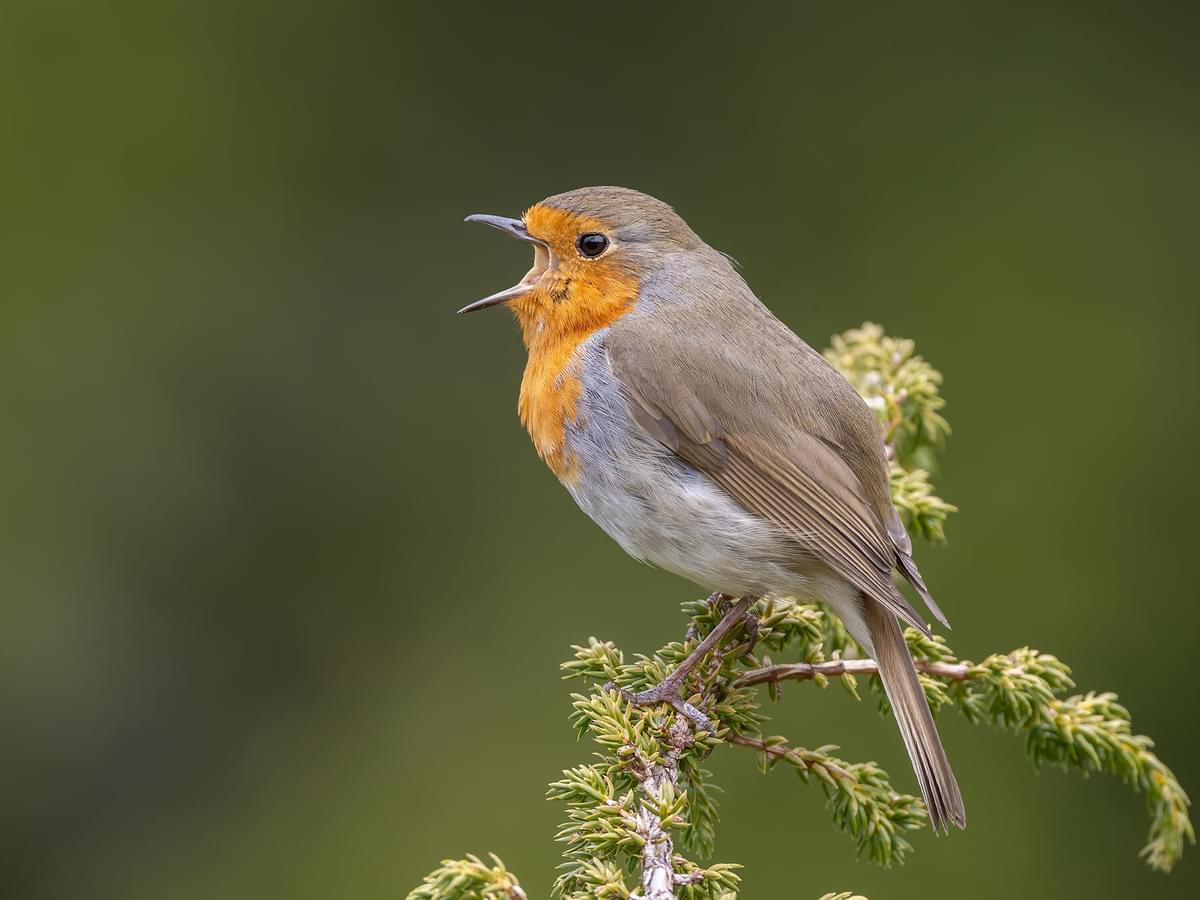
Length:
12.5cm to 14cm
Wingspan:
20cm to 22cm
Weight:
16g to 22g
Robin
The Robin (Erithacus rubecula) is a beloved UK garden bird that needs little introduction.
These bed-breasted songsters are common in gardens throughout the country. Robins are generally unobtrusive, although they can become very confiding.
Despite their sweet looks and voices, Robins are highly territorial, which explains why you’re most likely to spot just one or two in your garden. The same mated pair will visit your garden throughout the year to forage for insects and other invertebrates.
Common Starling
Sturnus vulgaris

Length:
19cm to 22cm
Wingspan:
31cm to 44cm
Weight:
60g to 100g
Starling
The Starling (Sturnus vulgaris) is a common and conspicuous garden bird across the United Kingdom.
These intelligent and wary birds are most beautiful in the breeding season when their plumage takes on an oily sheen and reflects green and purple shades in good light.
Starlings feed primarily on insects, although they will readily visit bird feeding tables, especially where suet, peanuts, and sunflower seeds are on offer.
Sadly, Starlings are in decline in rural areas of the UK, although they remain a familiar sight in urban and suburban parks and gardens.
Eurasian Wren
Troglodytes troglodytes
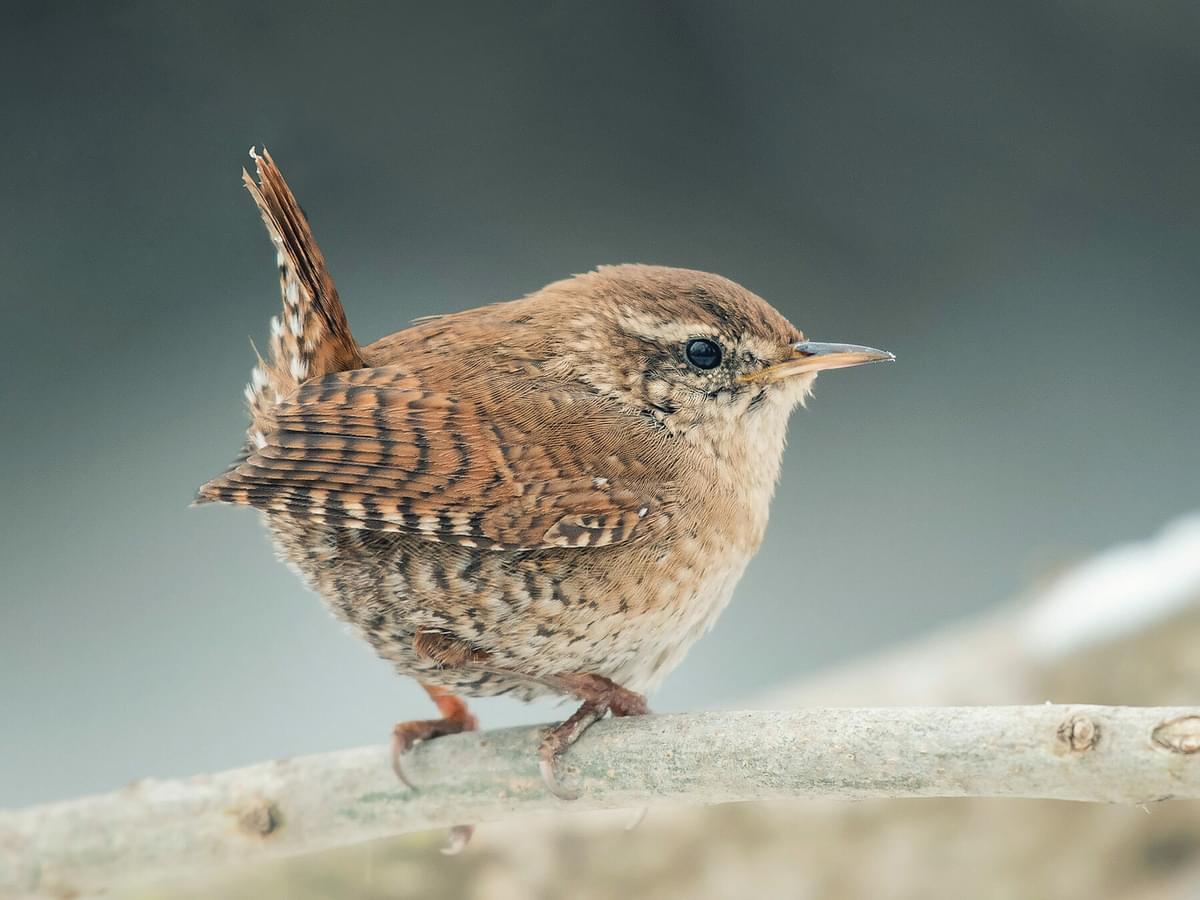
Length:
9cm to 10cm
Wingspan:
13cm to 17cm
Weight:
7g to 12g
Wren
The Wren (Troglodytes troglodytes) is a tiny, non-descript insect-eating bird that is very common in gardens throughout the United Kingdom.
In fact, Wrens are the UK’s most common bird species, with an estimated population of over eight million pairs!
Wrens are active little birds that forage for insects in the undergrowth. They will occasionally forage for scraps around bird tables, however, particularly in the winter when insects are in short supply. At this time, they may become bolder and easier to observe.
Long-tailed Tit
Aegithalos caudatus
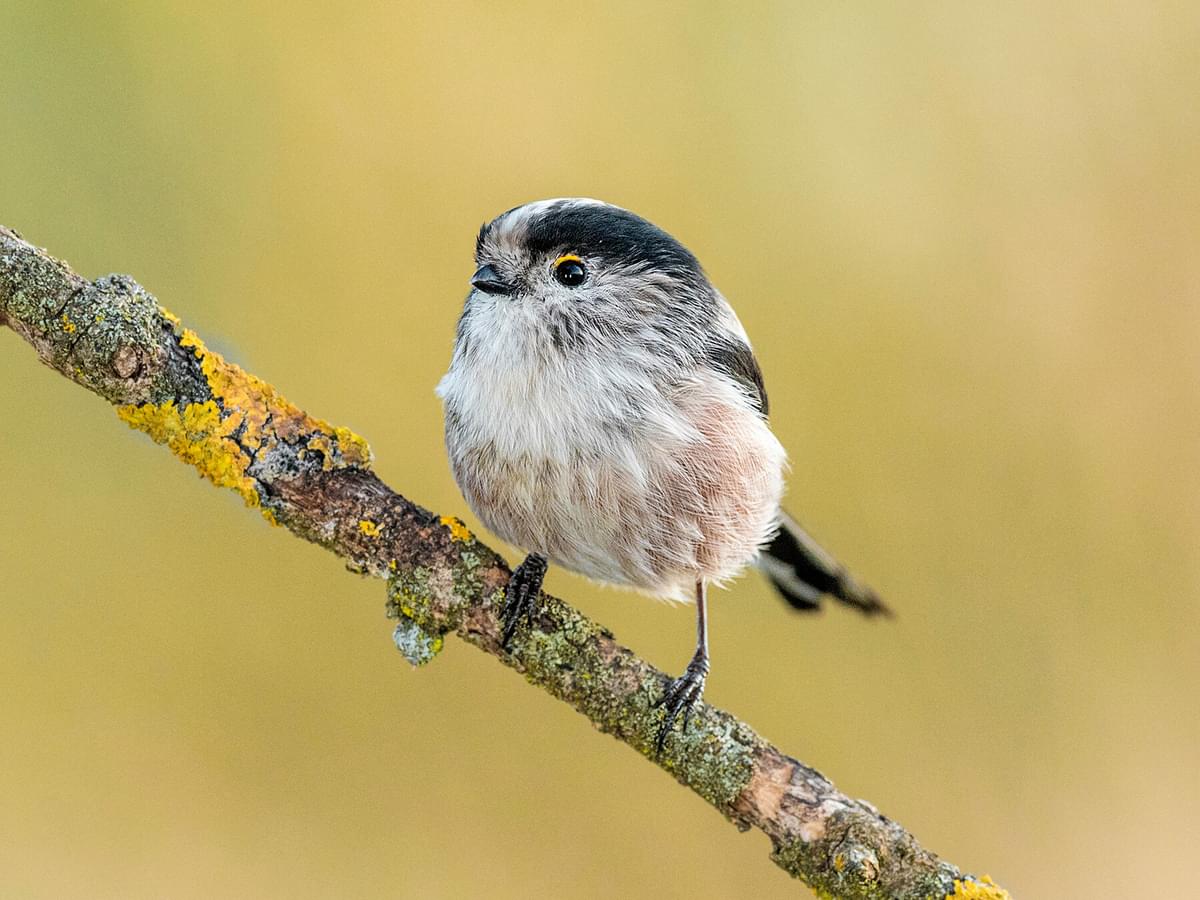
Length:
13cm to 15cm
Wingspan:
16cm to 19cm
Weight:
7g to 9g
Long-tailed Tit
The Long-tailed Tit (Aegithalos caudatus) is a unique little garden bird with some rather distinctive features.
Its tail is about the same length as its body, which is small and round. These birds have large heads without discernible necks and tiny black bills.
Long-tailed Tits visit a variety of habitats, and groups of up to twenty individuals may be a common sight in gardens during the winter.
These fascinating little birds feed predominantly on insects, although they are very partial to suet at bird feeders.
Greenfinch
Chloris chloris
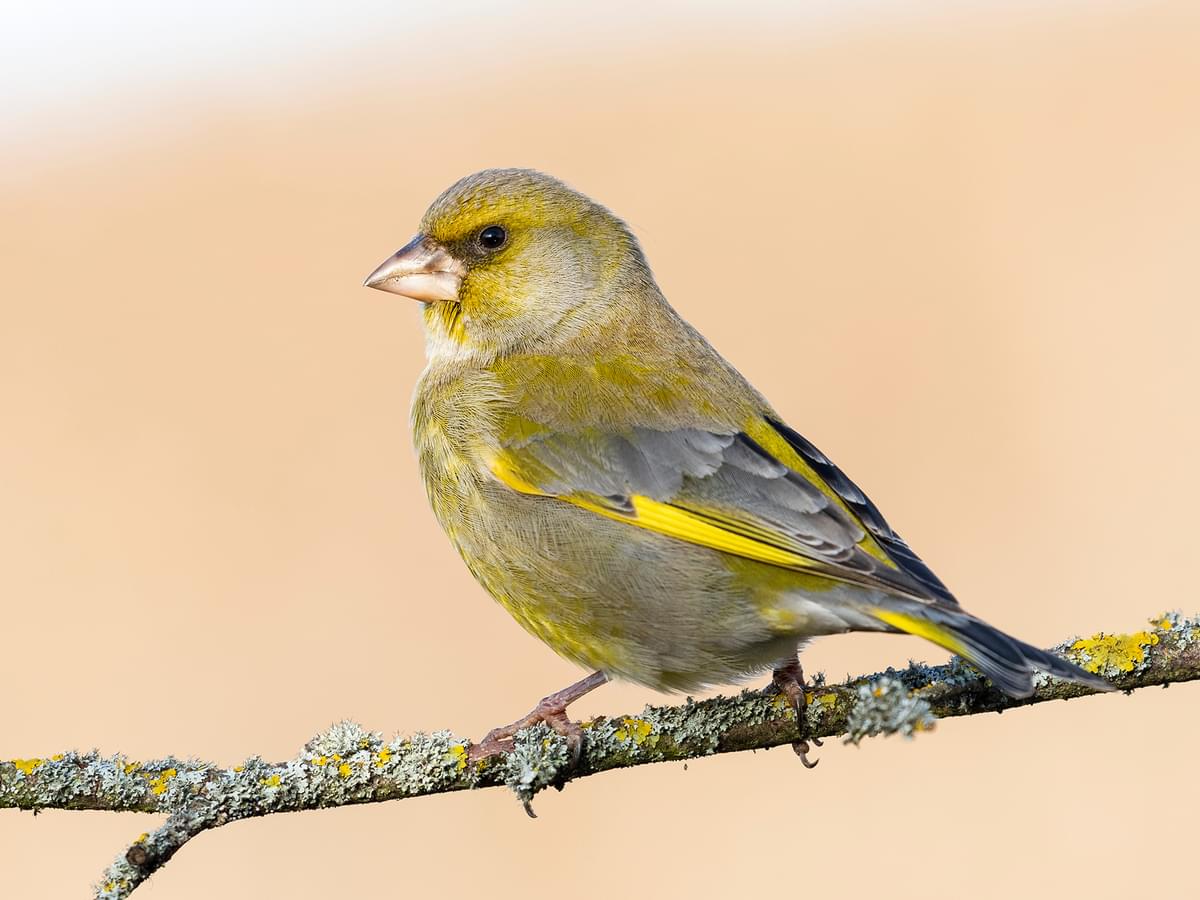
Length:
14cm to 16cm
Wingspan:
24cm to 28cm
Weight:
25g to 35g
Greenfinch
The Greenfinch (Chloris chloris) is a regular garden visitor and a welcome sight at the bird table. Males are greenish with bright yellow wing patches, whereas females are less colourful.
Greenfinches are commonly associated with humans and are quick to take advantage of a free meal.
Their decline resulted from the spread of a parasite-caused disease, which is why it is so important to keep bird baths and feeders clean.
Today, Greenfinch numbers are increasing, and you could spot them feeding on sunflower seeds or peanuts in your own garden throughout the year.
Chaffinch
Fringilla coelebs
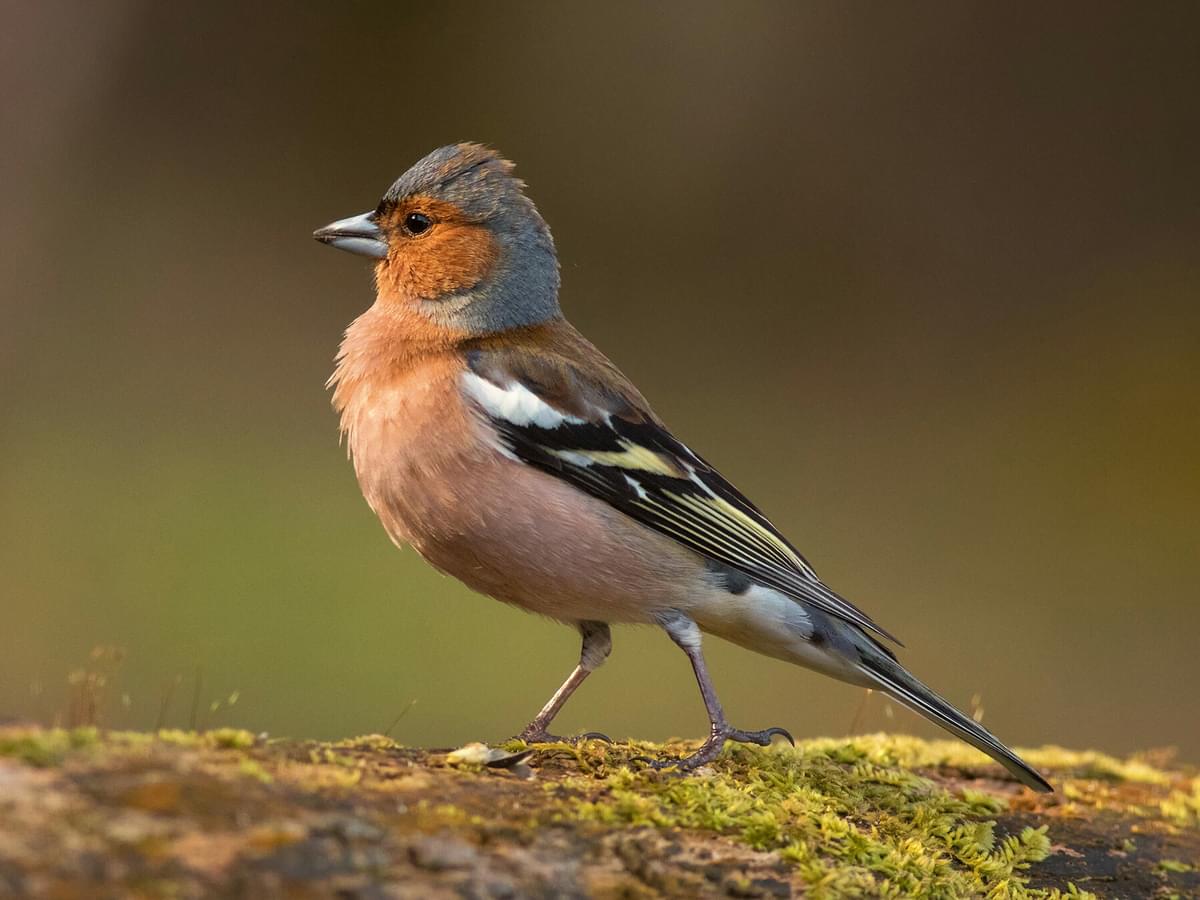
Length:
14cm to 16cm
Wingspan:
24cm to 28cm
Weight:
18g to 29g
Chaffinch
Chaffinches (Fringilla coelebs) are one of the most abundant birds across the UK and Ireland, so it should come as no surprise that they are extremely common visitors to gardens.
They can be spotted year-round, where they tend to prefer feeding under bird tables instead of on them for seeds that have made their way onto the floor.
Male Chaffinches are mainly orange, with a mixture of browns, greys, blacks, whites and yellow, whereas females are less colourful, and are mostly brown, with black and white detailing, particularly on the wings.
You'll often hear chaffinches before you see them, as they are a vocal species with a distinctive, yet wonderful array of loud calls.
House Sparrow
Passer domesticus
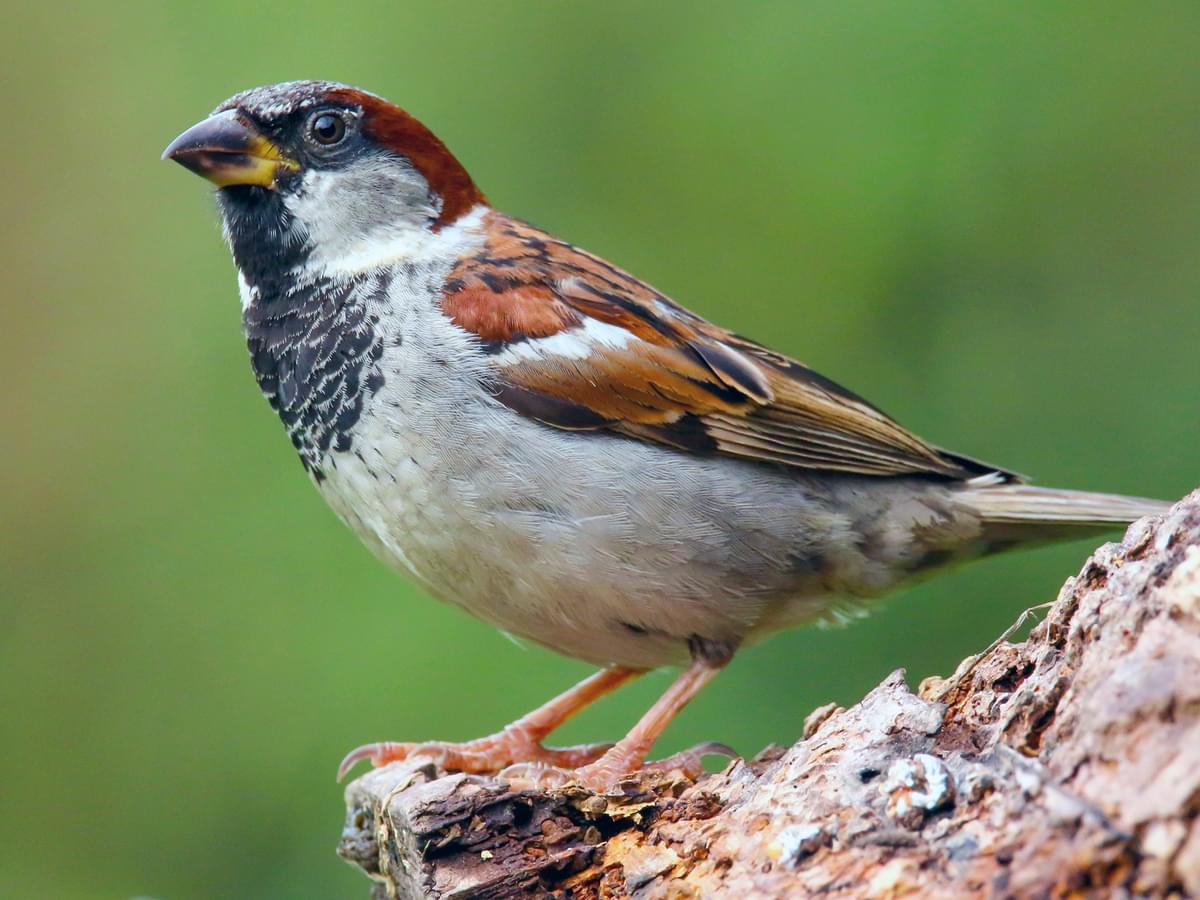
Length:
14cm to 18cm
Wingspan:
19cm to 25cm
Weight:
24g to 39g
House Sparrow
The House Sparrow (Passer domesticus) is an abundant and familiar garden bird species in the UK whose call is a familiar sound to people all over the country, whether they realise it or not!
These small seed-eating birds nest in cavities in our homes and buildings and forage in our gardens and parks, and streets.
House Sparrows tend to forage in pairs, and males have distinctive black throats and facial markings, coupled with rich brown backs, greyish underparts, and white markings on their wings and necks. Females are drab in comparison and relatively nondescript little birds.
Look out for these birds throughout the year.
Dunnock
Prunella modularis
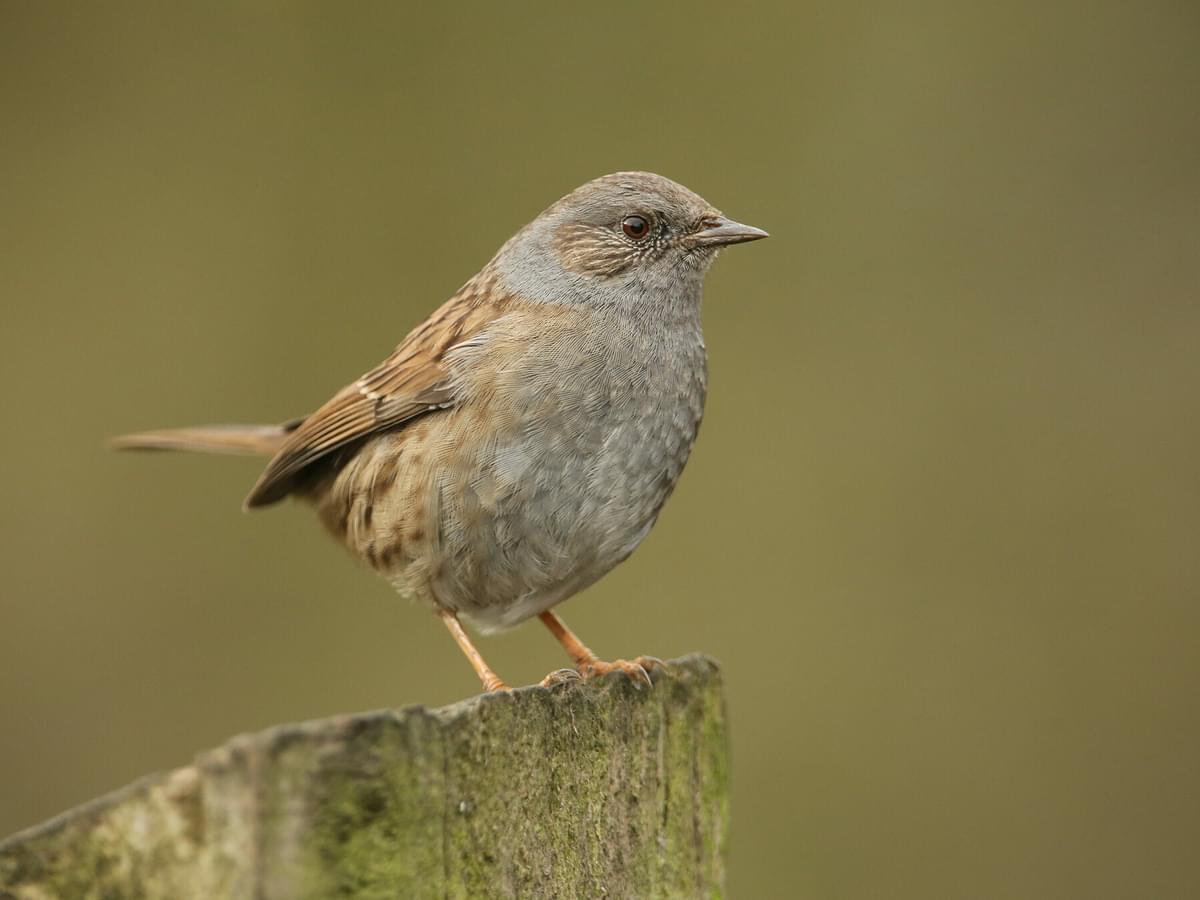
Length:
13cm to 14.5cm
Wingspan:
19cm to 21cm
Weight:
19g to 24g
Dunnock
The Dunnock (Prunella modularis) is a common but inconspicuous garden bird in the United Kingdom. These birds occur throughout the United Kingdom, with the exception of the Scottish Highlands.
Look out for these well-camouflaged birds as they forage on the ground near the protection of shrubs and other vegetation.
Both sexes are variously marked in grey and brown, with a sharp black bill and pinkish legs.
Don’t expect to see too many Dunnocks at your feeding station in the summer unless you provide mealworms. However, these birds will feed on seeds in the winter when insect numbers decrease.
Woodpigeon
Columba palumbus
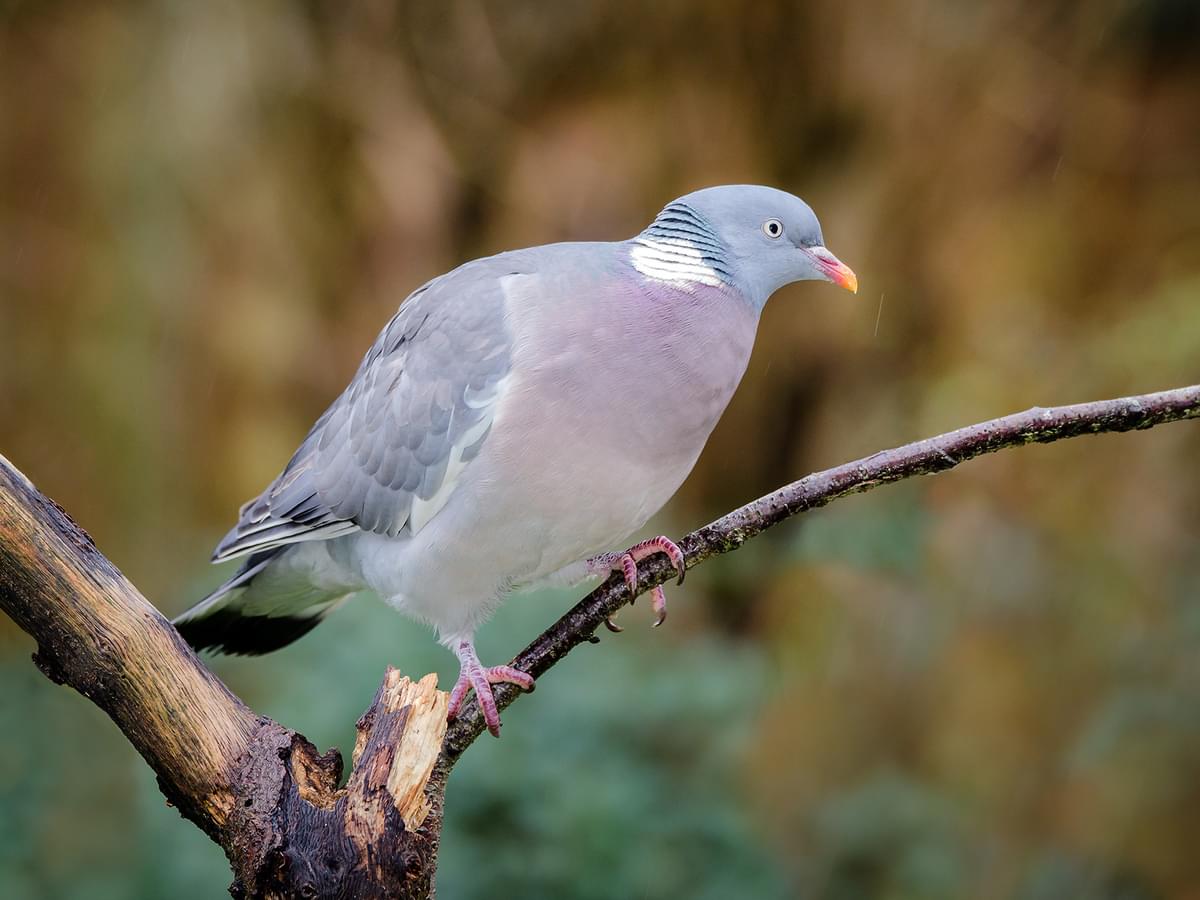
Length:
40cm to 45cm
Wingspan:
75cm to 80cm
Weight:
400g to 600g
Woodpigeon
The Wood Pigeon (Columba palumbus) is a large and common garden bird that forages and breeds in British and Irish gardens throughout the year.
These pastel grey and pink pigeons are attractive birds, and their prominent white neck bars distinguish them from other doves and pigeons in the UK.
The Woodpigeon is a ground-feeding bird, typically seen searching the lawn for seeds and other plant material. However, they will readily feed on grain and birdseed mixes when available.
Carrion Crow
Corvus corone

Length:
44cm to 51cm
Wingspan:
84cm to 100cm
Weight:
400g to 600g
Carrion Crow
The Carrion Crow (Corvus corone) is a bold and intelligent bird from the corvid family and an exciting bird to have around the garden.
The Carrion Crow is often wary of humans, although many have learned to take advantage of garden feeding stations, and they may become regular visitors if left to forage in peace.
Despite their sinister name, these large, all-black birds have a varied diet and will feed on anything from grain to insects and fruit.
Magpie
Pica pica

Length:
44cm to 46cm
Wingspan:
52cm to 60cm
Weight:
200g to 250g
Magpie
The Magpie (Pica pica) is another clever corvid that will visit UK gardens to forage. These pied birds are instantly recognisable by their long iridescent tails and contrasting black and white plumage.
The Magpie is common in the southern half of the UK but scarce in large parts of Scotland.
Despite their striking looks and fascinating behaviours, Magpies are not always welcome garden visitors because they can be aggressive towards other bird species.
If you do want to attract these birds, provide their favourite meaty meals like suet, dog food, or mealworms.
Yellowhammer
Emberiza citrinella
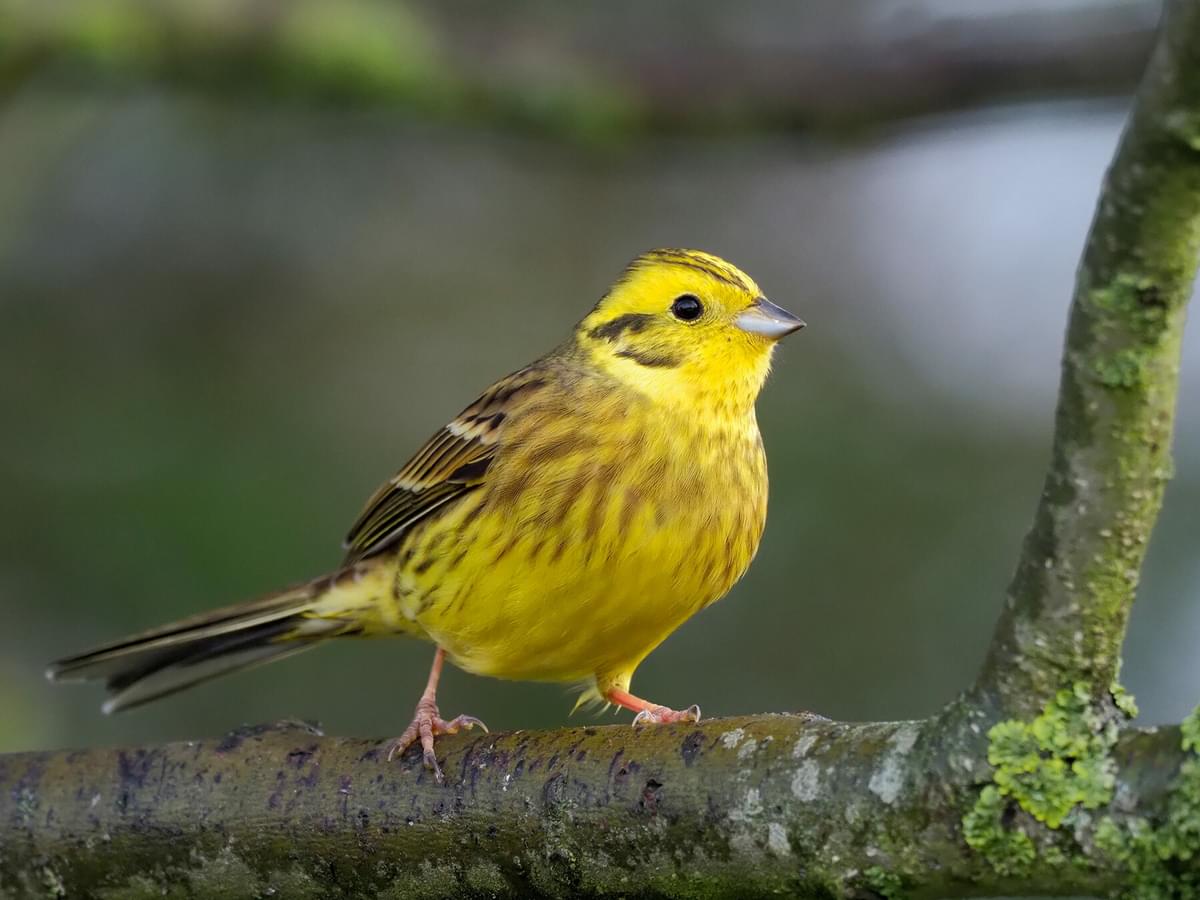
Length:
15.5cm to 17cm
Wingspan:
23cm to 29.5cm
Weight:
20g to 36g
Yellowhammer
The Yellowhammer (Emberiza citrinella) is a brightly coloured bunting species that will visit garden bird feeding tables, particularly in winter when seeds become a more important part of their diet.
Both sexes are boldly marked in yellow plumage with black-streaked rufous upper parts. However, males are certainly the most colourful.
The Yellowhammer has a wide distribution in the United Kingdom, particularly in the Southeast. However, they are absent from many higher-lying areas.
Sadly, the species has suffered significant declines and is on the UK’s conservation red list.
Eurasian Jay
Garrulus glandarius
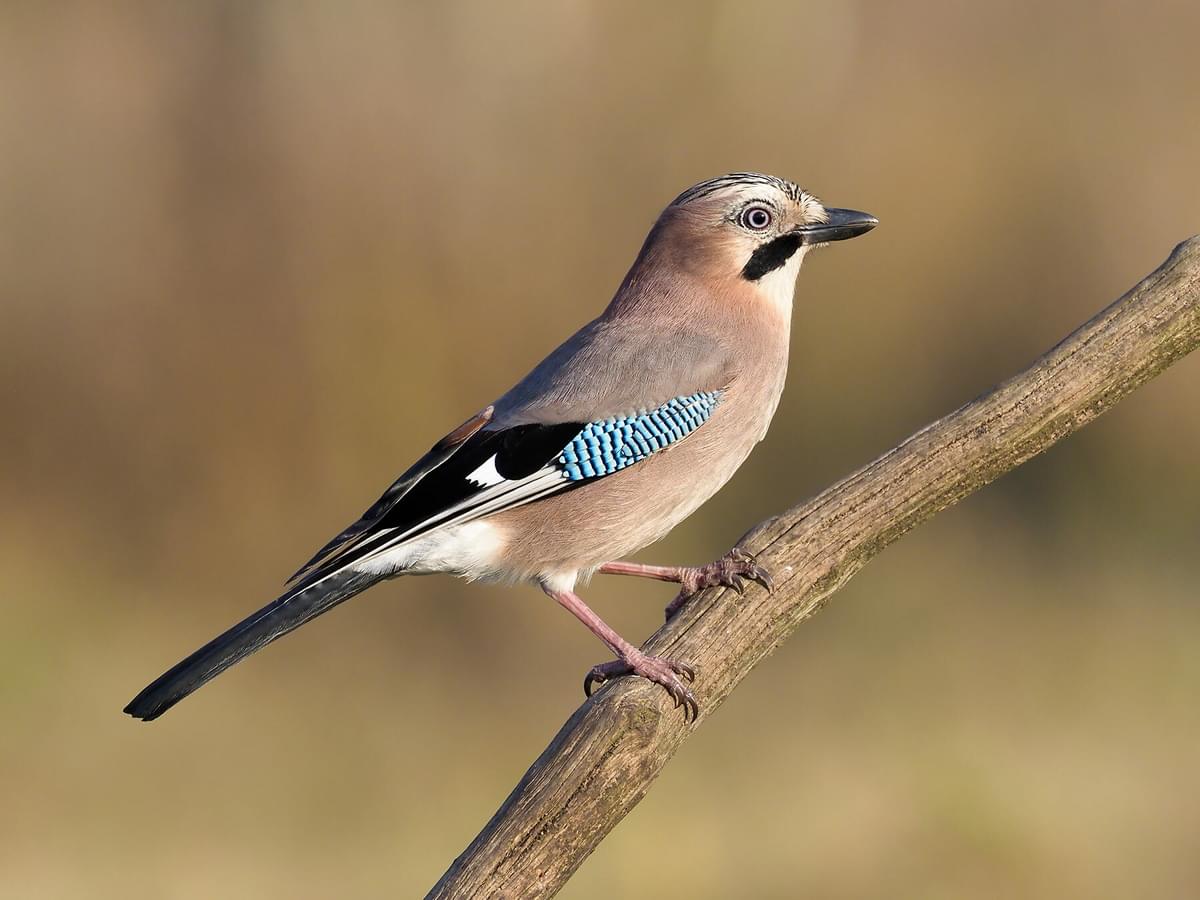
Length:
32cm to 35cm
Wingspan:
52cm to 58cm
Weight:
140g to 190g
Jay
The Jay (Garrulus glandarius) is a beautiful woodland bird from the same family as magpies, crows, and ravens.
These colourful corvids are instantly recognisable by their pastel pinkish plumage, bold black moustache stripe, and the bright blue barred feathers on their wings.
Eurasian Jays will visit mature gardens, especially where they can find their favourite food - acorns.
Birdwatchers can also attract these shy birds by providing suet, peanuts, and sunflower seeds.
Great Spotted Woodpecker
Dendrocopos major

Length:
23cm to 26cm
Wingspan:
38cm to 44cm
Weight:
70g to 98g
Great Spotted Woodpecker
The Great Spotted Woodpecker (Dendrocopos major) is a common woodland bird from Wales, England, and southern Scotland.
These black, white, and red birds often visit mature gardens where they will readily feed from bird feeders offering fat balls, peanuts, and sunflower seeds.
The Great Spotted Woodpecker is a truly eye-catching bird as it scrambles along the trunks of trees and moves between perches with its characteristic dipping flight.
One of three woodpecker species in the UK, this species is larger and more common than the Lesser Spotted Woodpecker.
Eurasian Collared Dove
Streptopelia decaocto

Length:
31cm to 33cm
Wingspan:
47cm to 55cm
Weight:
150g to 220g
Collared Dove
The Collared Dove (Streptopelia decaocto) is a relative newcomer to the United Kingdom, first colonising the country in the mid-1900s.
Today, these common birds are a familiar species in gardens almost everywhere except the Highlands of Scotland.
These soft-grey coloured doves have a distinctive black band that surrounds the back half of their neck.
Collared Doves will forage for seeds and buds together with other ground feeders like Woodpigeons, and they often build their flimsy twig nests in gardens and urban areas.
European Green Woodpecker
Picus viridis
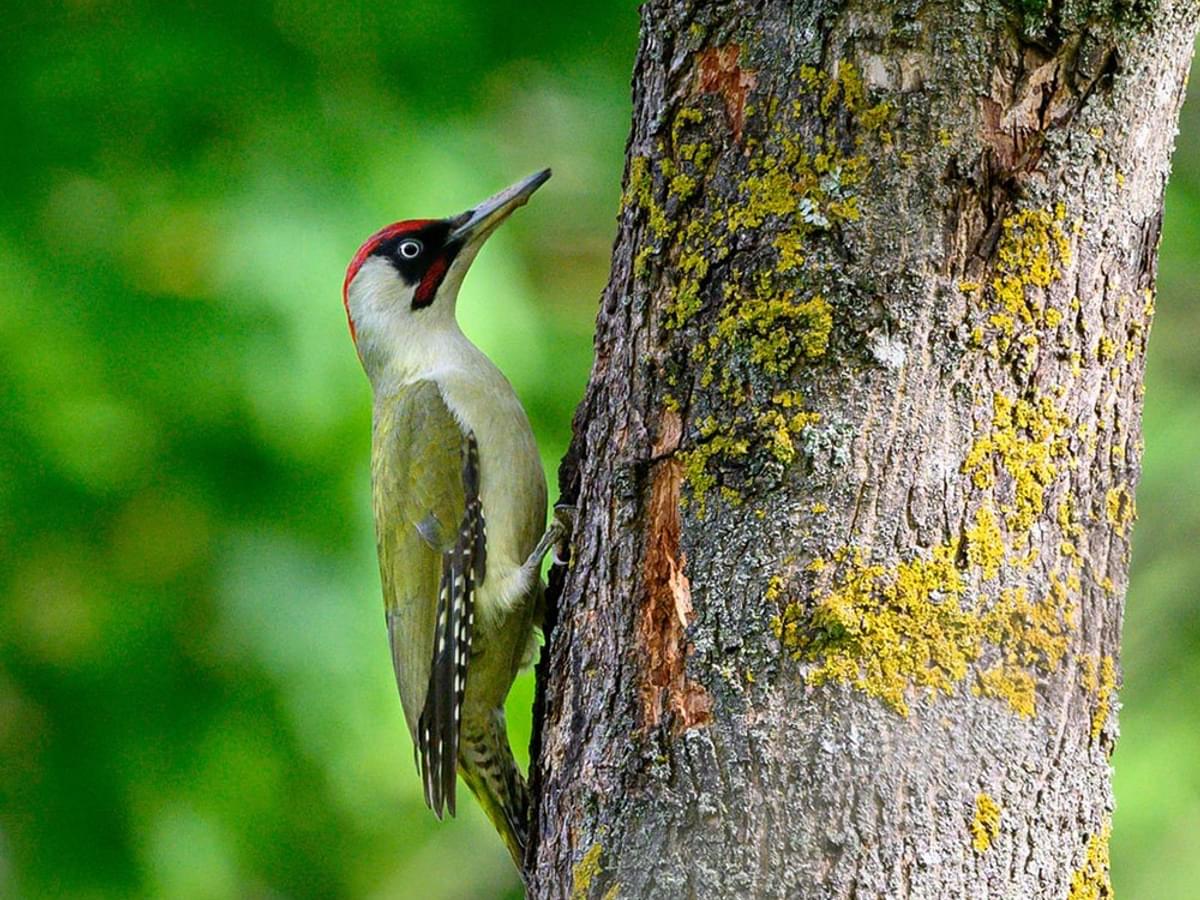
Length:
30cm to 36cm
Wingspan:
40cm to 42cm
Weight:
180g to 220g
Green Woodpecker
The Green Woodpecker (Picus viridis) is a large species with an unmistakable green back and red cap.
These impressive birds are specialist ant-eaters, but that doesn’t mean you can’t enjoy sightings in your very own garden.
European Green Woodpeckers occur across most of Wales and England but are absent from Northern Ireland and most of Scotland.
They are ground feeders that often search for ants on lawns. A healthy lawn in an established garden could certainly attract one of these shy birds.
Jackdaw
Corvus monedula
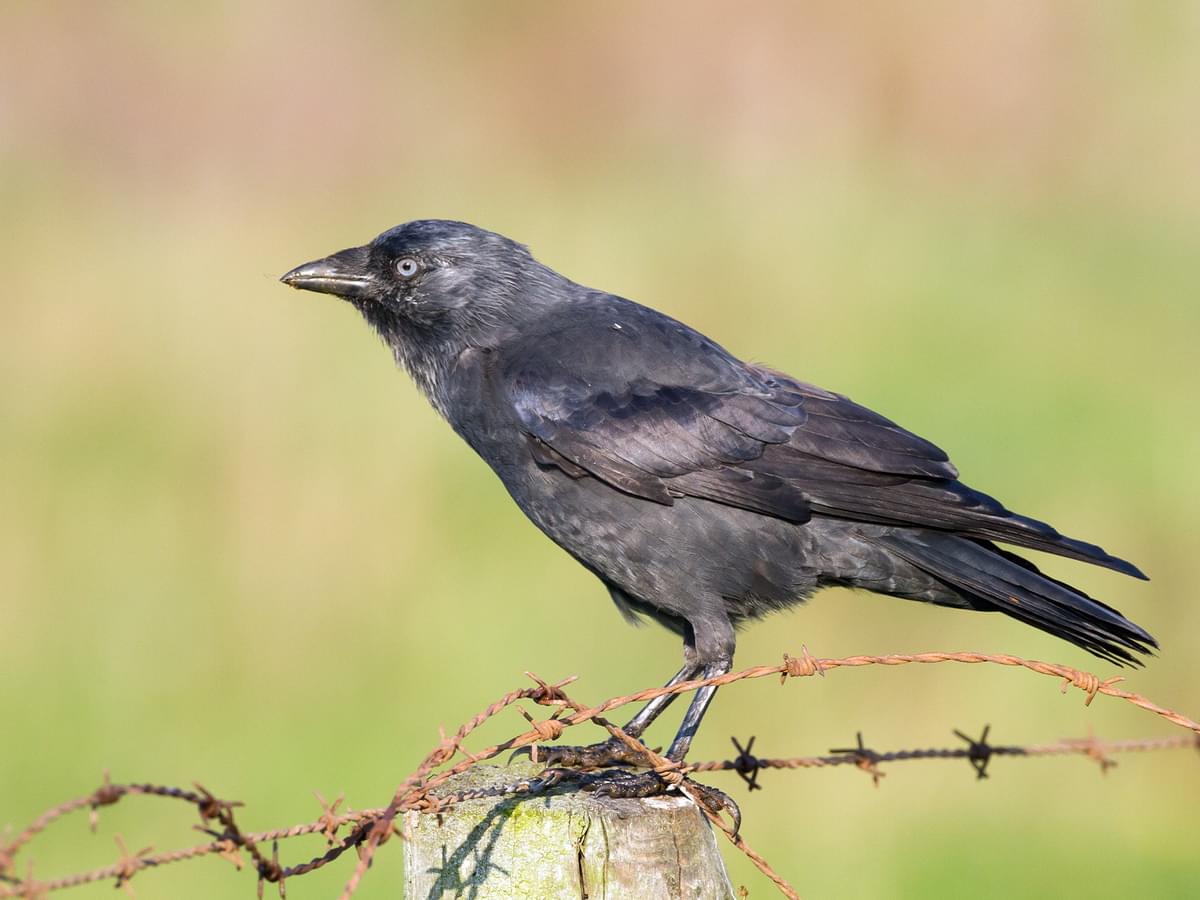
Length:
34cm to 39cm
Wingspan:
64cm to 73cm
Weight:
220g to 270g
Jackdaw
The Jackdaw (Corvus monedula) is a small crow species with piercing pale blue eyes and a black face. The rest of their body is a dark grey shade.
These adaptable corvids are common in many habitats, including gardens across the United Kingdom.
The Jackdaw will readily visit bird tables, and they are small enough to feed from hanging bird feeders. These fascinating birds also nest in buildings and trees in established gardens.
Jackdaws are resident in the United Kingdom, and you can enjoy sightings throughout the year.
Goldcrest
Regulus regulus
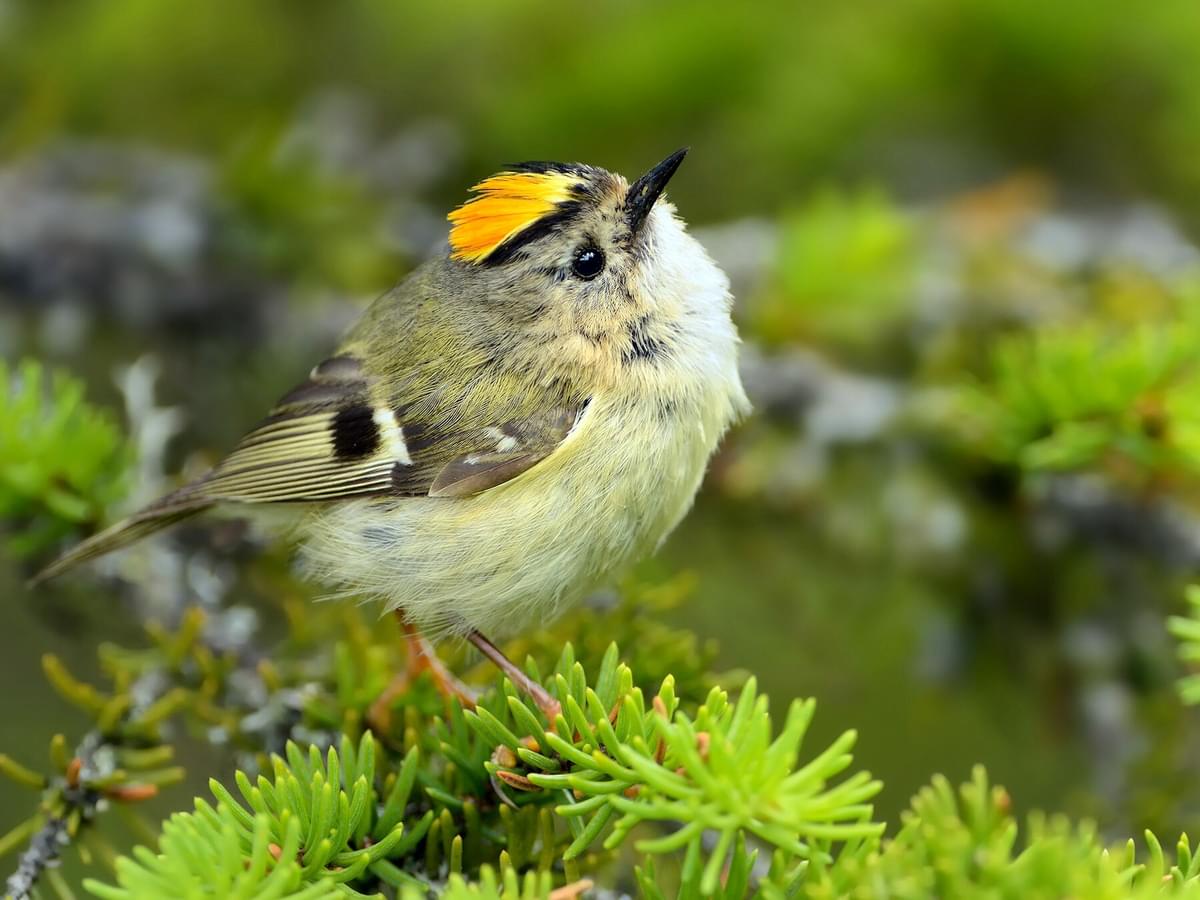
Length:
8.5cm to 9.5cm
Wingspan:
13cm to 15cm
Weight:
4.5g to 7g
Goldcrest
The Goldcrest (Regulus regulus) is the UK's smallest bird and a lovely species to observe in your own garden.
These tiny birds weigh just six grams or less and are named for their black and yellow crowns.
The Goldcrest is a short-lived species, common all over the UK. Attract these birds in the winter by providing small morsels of mild cheese, suet, or mealworms.
Bullfinch
Pyrrhula pyrrhula

Length:
14cm to 16cm
Wingspan:
22cm to 26cm
Weight:
21g to 27g
Bullfinch
The Bullfinch (Pyrrhula pyrrhula) is a robust finch species with a heavy bill for crushing seeds.
Males have fiery red bellies and grey backs, while females have brown backs and greyish underparts.
Unfortunately, the Bullfinch is on the UK’s amber list due to declines in the late 1900s.
These beautiful finches are not the commonest of garden birds, but they can be attracted by providing a clean source of water, and a quality bird seed mix.
What are garden birds?
Garden birds do not fall into any scientific classification but rather comprise a collection of generally small to medium-sized species that frequent gardens.
Established gardens with a variety of plants provide wonderful habitats for many bird species, particularly those that are naturally adapted to life in woodlands.
How to attract more garden birds
Birds are naturally attracted to environments where they can find food, water, and shelter. Landscaping your garden to attract birds is an excellent way to create a haven for local birdlife, but you don’t necessarily have to go to extremes.
Simply providing fresh, healthy food sources such as seeds, nuts, fruit, mealworms, and fat balls will attract a great variety of garden bird species. A regularly cleaned birdbath or water feature is another effective way to attract more feathered friends.

Blue tit and Great tit eating peanuts from a bird feeder
Best bird food for garden birds
Different birds prefer different food sources, so it would be difficult to pick the single best food for British and Irish garden birds. If you were to choose just one, a quality wild bird seed mix would be a good choice. Many birds will feed on seeds, including finches, doves, sparrows and tits.
Of course, there are many other great food sources to attract wild birds to your garden. Try the following food types to attract an even greater variety of garden birds:
- Mealworms
- Fat balls/suet
- Fruit
What is the most common garden bird in the UK?
The House Sparrow is the most common garden bird in the UK, with over 1.7 million individuals counted in 2022. Despite their abundance, these birds are in decline, so welcome them to your garden by creating a bird-friendly environment for these familiar birds to enjoy.

House Sparrows are the most common bird spotted in UK gardens
What is the largest garden bird in the UK?
The Wood Pigeon is the biggest common bird species in most UK gardens. However, larger species such as Carrion Crows, Buzzards, Sparrowhawks, Red Kites, and even Mallards may visit your garden, especially if you live in a rural area and have a large garden with suitable habitat.

The largest, most common garden bird species in the UK, the Woodpigeon
What is the smallest garden bird in the UK?
The UK's smallest garden bird is the enchanting little Goldcrest. They share the title of Britain’s smallest bird with the similar (but rarer) Firecrest.

The smallest garden bird species in the UK, the Goldcrest
How many types of garden birds are there in the UK?
Of the over 600 bird species recorded in the UK, twenty to thirty are common in gardens. The diversity of species varies depending on where you live and the quality of the surrounding habitats.
However, watching the skies above your home will reveal many more bird species, particularly in the mornings and evenings, as birds leave and return to their evening roosts.
What garden birds are native to the UK?
Practically all the bird species that regularly visit UK gardens are native to the country.
The only common exceptions are Feral Pigeons, which descend from the wild Rock Dove that is indeed native to Scotland and Ireland, and the Ring-necked Parakeet, which has become feral in the Southeast.
Are garden birds protected in the UK?
All wild bird species in the UK are protected by law (Wildlife and Countryside Act 1981). This protection includes their young, eggs, and even nests. Consider the consequences for garden birds before doing any major work in your garden or renovations on your home.
On this page
- Blackbird
- Blue Tit
- Great Tit
- Goldfinch
- Robin
- Starling
- Wren
- Long-tailed Tit
- Greenfinch
- Chaffinch
- House Sparrow
- Dunnock
- Woodpigeon
- Carrion Crow
- Magpie
- Yellowhammer
- Jay
- Great Spotted Woodpecker
- Collared Dove
- Green Woodpecker
- Jackdaw
- Goldcrest
- Bullfinch
- What are garden birds?
- How to attract more garden birds
- Best bird food for garden birds
- What is the most common garden bird in the UK?
- What is the largest garden bird in the UK?
- What is the smallest garden bird in the UK?
- How many types of garden birds are there in the UK?
- What garden birds are native to the UK?
- Are garden birds protected in the UK?














